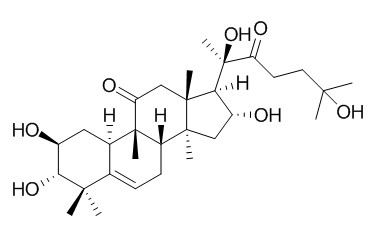Cucurbitacin IIb
Cucurbitacin IIb is one of the major active compounds in Hemsleyadine tablets which have been used for clinical treatment of bacillary dysentery, enteritis and acute tonsilitis. Cucurbitacin IIb exhibits its anti-inflammatory activity through modulating multiple cellular behaviors and signaling pathways, leading to the suppression of the adaptive immune response. Cucurbitacin IIb also can induce apoptosis of concanavalin A-activated mouse lymphocytes.
Inquire / Order:
manager@chemfaces.com
Technical Inquiries:
service@chemfaces.com
Tel:
+86-27-84237783
Fax:
+86-27-84254680
Address:
1 Building, No. 83, CheCheng Rd., Wuhan Economic and Technological Development Zone, Wuhan, Hubei 430056, PRC
Providing storage is as stated on the product vial and the vial is kept tightly sealed, the product can be stored for up to
24 months(2-8C).
Wherever possible, you should prepare and use solutions on the same day. However, if you need to make up stock solutions in advance, we recommend that you store the solution as aliquots in tightly sealed vials at -20C. Generally, these will be useable for up to two weeks. Before use, and prior to opening the vial we recommend that you allow your product to equilibrate to room temperature for at least 1 hour.
Need more advice on solubility, usage and handling? Please email to: service@chemfaces.com
The packaging of the product may have turned upside down during transportation, resulting in the natural compounds adhering to the neck or cap of the vial. take the vial out of its packaging and gently shake to let the compounds fall to the bottom of the vial. for liquid products, centrifuge at 200-500 RPM to gather the liquid at the bottom of the vial. try to avoid loss or contamination during handling.
Biomolecules.2021, 11(10):1537.
Antioxidants (Basel).2021, 10(10):1638.
Front. Physiol.2022, 790345.
BMC Complement Altern Med.2014, 14:242
British Jou. Med.&Med. Research2014, 1802-1811
Industrial Crops and Products2024, 219:119123
The Catharanthus Genome2022,35-83.
J Holistic Integrative Pharm.2023, 4(1):14-28
Food Bioscience2022, 50:102187.
Food Chem.2022, 373(Pt B):131364.
Related and Featured Products
PLoS One. 2014 Feb 25;9(2):e89751.
Cucurbitacin IIb exhibits anti-inflammatory activity through modulating multiple cellular behaviors of mouse lymphocytes.[Pubmed:
24587010]
Cucurbitacin IIb (CuIIb) is one of the major active compounds in Hemsleyadine tablets which have been used for clinical treatment of bacillary dysentery, enteritis and acute tonsilitis. However, its action mechanism has not been completely understood. This study aimed to explore the anti-inflammatory activity of Cucurbitacin IIb and its underlying mechanism in mitogen-activated lymphocytes isolated from mouse mesenteric lymph nodes.
METHODS AND RESULTS:
The results showed that Cucurbitacin IIb inhibited the proliferation of concanavalin A (Con A)-activated lymphocytes in a time- and dose-dependent manner. Cucurbitacin IIb treatment arrested their cell cycle in S and G2/M phases probably due to the disruption of the actin cytoskeleton and the modulation of p27(Kip1) and cyclin levels. Moreover, the surface expression of activation markers CD69 and CD25 on Con A-activated CD3(+) T lymphocytes was suppressed by CuIIb treatment. Both Con A- and phorbol ester plus ionomycin-induced expression of TNF-α, IFN-γ and IL-6 proteins was attenuated upon exposure to CuIIb. Mechanistically, Cucurbitacin IIb treatment suppressed the phosphorylation of JNK and Erk1/2 but not p38 in Con A-activated lymphocytes. Although Cucurbitacin IIb unexpectedly enhanced the phosphorylation of IκB and NF-κB (p65), it blocked the nuclear translocation of NF-κB (p65). In support of this, Cucurbitacin IIb significantly decreased the mRNA levels of IκBα and TNF-α, two target genes of NF-κB, in Con A-activated lymphocytes. In addition, Cucurbitacin IIb downregulated Con A-induced STAT3 phosphorylation and increased cell apoptosis.
CONCLUSIONS:
Collectively, these results suggest that Cucurbitacin IIb exhibits its anti-inflammatory activity through modulating multiple cellular behaviors and signaling pathways, leading to the suppression of the adaptive immune response.



